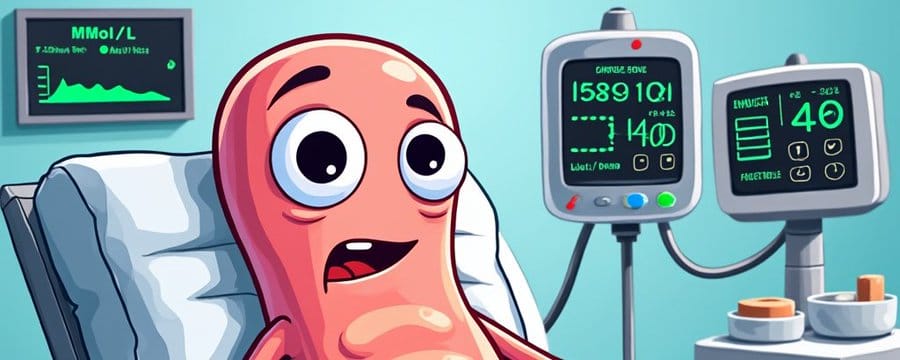
Diabetic Ketoacidosis (DKA) is a severe and potentially life-threatening condition that primarily affects individuals with type 1 diabetes, though it can occasionally occur in those with type 2 diabetes. DKA arises when there isn't enough insulin in the body, leading to high blood sugar (hyperglycaemia) and the release of ketones into the bloodstream. Insulin is crucial for allowing glucose to enter cells for energy; without it, the body begins breaking down fat for fuel, producing ketones.
Mechanism
- Insulin Deficiency: Lack of insulin prevents glucose from entering cells for energy.
- Hyperglycaemia: Blood sugar levels rise because glucose remains in the blood.
- Ketone Production: The liver breaks down fat into fatty acids and then into ketones, which accumulate in the blood, making it acidic.
- Acidosis: The blood becomes too acidic, which can lead to serious complications if not treated promptly.
Symptoms of DKA
- Fruity breath odour (from acetone, a ketone)
- Excessive thirst and frequent urination
- Nausea, vomiting, or abdominal pain
- Shortness of breath
- Confusion or altered mental state
- Rapid breathing (Kussmaul respiration)
- Weakness or fatigue
Risks Associated with DKA
- Dehydration: Due to high blood sugar, the body tries to expel sugar through urine, leading to loss of fluids and electrolytes.
- Electrolyte Imbalance: Can disrupt heart rhythm or cause neurological problems.
- Cerebral Oedema: Particularly dangerous in children, this swelling of the brain can occur during treatment if fluids are managed improperly.
- Shock: Severe dehydration might lead to circulatory shock.
- Death: If left untreated, DKA can be fatal.
Treatment of DKA
Treatment for DKA involves:
- Insulin Therapy: Intravenous insulin is administered to stop the breakdown of fats and to help glucose enter cells.
- Fluid Replacement: Intravenous fluids are given to correct dehydration and electrolyte imbalances. This is usually done with saline solutions initially, transitioning to fluids with potassium as levels are monitored.
- Electrolyte Correction: Replenishing potassium, sodium, and other electrolytes which are depleted.
- Monitoring Blood Sugar and Ketones: Continuous monitoring to adjust insulin and fluid therapy as needed.
- Treating the Underlying Cause: If DKA was triggered by an infection or another illness, treatment for that condition is necessary.
- Education: Post-recovery, education on diabetes management is crucial to prevent recurrence. This includes understanding insulin use, monitoring blood sugar, and recognising early signs of DKA.
Prevention
- Regular Monitoring: Blood glucose levels should be checked frequently, especially when ill or during life changes.
- Insulin Adherence: Never miss insulin doses.
- Sick Day Rules: Adjust insulin and fluids appropriately during illness.
- Education: Knowing the signs of DKA and when to seek emergency care.
In conclusion, DKA is a serious medical emergency that requires prompt and effective treatment. Understanding its causes, recognising its symptoms early, and knowing how to manage diabetes can significantly reduce the risk of this condition among those with type 1 diabetes. Awareness, education, and vigilant health management are key to prevention and effective treatment.

Member discussion: